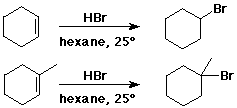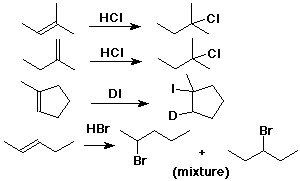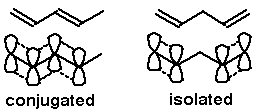
Chapter 6 Notes: Alkene Reactions

Reaction Types
- additions
A + B --> C
H-Cl + CH2=CH2 --> CH3-CH2-Cl
- eliminations
X --> Y + Z
CH3-CH2-Cl --> CH2=CH2 + H-Cl
- substitutions
A-B + C-D --> A-C + B-D
CH4 + Cl2 --> CH3-Cl + H-Cl
- rearrangements
X --> Y
cyclopropane --> propene
Reaction Mechanisms
- a step-by-step account of how a reaction occurs (and why)
- bond-breaking steps:
homolytic: one electron to each fragment
(generates radicals)
heterolytic: both electrons to one fragment
(generates ions)
- bond-making steps:
homogenic or heterogenic
Electron Movement
- electron-pushing arrows indicate the flow of electrons in
a mechanism
- electrophile:
electron-deficient species seeking a pair of electrons (a Lewis
acid )
- nucleophile:
electron-rich species that can provide a pair of electrons (a
Lewis base)
Potential Energy Diagrams
- visualize energy changes during a reaction
- y-axis = potential energy (G or H)
uphill = higher energy
downhill = lower energy
- x-axis = reaction coordinate
Heats of Reaction
- delta H - enthalpy change
- delta H = H(products) - H(reactants)
- exothermic - H < 0 (negative)
reaction gives off heat
- endothermic - H > 0 (positive)
reaction absorbs heat
Activation Energy
- there is usually an energy barrier between reactants and
products
- activation energy represents the highest amount of energy
necessary to carry out the reaction (starting from reactants)
The Transition State
- structure of the molecule(s) at the highest point along the
reaction pathway
- the stability of the transition state (relative to reactants)
determines Ea (rate of reaction)
Kinetics
- Arrhenius equation:
k = A exp( -Ea/RT )
- exponential temperature dependence
if Ea < 20 kcal/mol, reactions are usually fast at room temperature
for Ea > 20 kcal/mol, reactions usually require heating
HCl plus Ethene
- CH2=CH2 + H-Cl --> CH3-CH2-Cl
- an electrophilic addition
- reaction type: addition
- reagent type: an electrophile
HCl, actually H+, a strong Lewis acid
Addition Mechanism

- pi bond is relatively reactive, especially towards electrophiles
it provides a good source of electrons
- addition of H+ to CH2=CH2 forms a new C-H sigma bond
the electrons for the new bond came from the pi bond
the other C is left with only 6 e-
Carbocation Intermediate
- an intermediate is formed in the reaction mechanism
CH2=CH2 + H+ --> CH3-CH2+
- carbocation: a carbon atom with only 3 bonds (6 e-) and a
positive charge
- structure: sp2 hybridized (trigonal)
Formation of Chloroethane
- the reaction is completed as chloride anion (a nucleophile)
adds to the carbocation (an electrophile)
CH3-CH2+ + Cl- ---> CH3-CH2-Cl
Alkene Addition Reactions
- pi bonds undergo addition reactions
CH2=CH2 + HCl --> CH3CH2Cl
- in general,
C=C + HX --> H-C-C-X
- alkenes react with hydrogen halides to form alkyl halides
Addition of HX to Alkenes

- cyclohexene + HBr --> bromocyclohexane
- 1-methylcyclohexene + HBr --> 1-bromo-1-methylcyclohexane
(not 1-bromo-2-methylcyclohexane)
Reaction Notation
- reactants -------> products
focus on the organic reactants and products
- show reagents over the arrow
- show solvent and conditions under the arrow
(or show full balanced reaction)
Orientation of Addition
- regiochemistry:
specific orientation of addition
(which C gets H, which gets X?)
- alkene additions are regioselective:
one direction of addition is usually preferred
Markovnikov's Rule
- the original:
add H to the C with more H's
(or to the C with fewer alkyl groups)
- the reason:
add H+ to form the more stable cation
CH3CH=CH2 + HCl --->
CH3CH+CH3 (not CH3CH2CH2+)
---> CH3CHClCH3 (not CH3CH2CH2Cl)
Carbocations

- structure: trigonal (sp2)
- stability: 3° > 2° > 1°
- more alkyl groups stabilize a cation by electron donation
to the electron-deficient (6-electron) carbocation
- hyperconjugation: electron donation from adjacent C-H sigma
bond to empty p orbital of teh carbocation
Markovnikov Addition

Carbocation Rearrangements
- carbocations easily rearrange to more stable forms
e.g., 1° --> 2° , 1° --> 3° , or 2°
--> 3°
Hydration of Alkenes
- alkene + water --> alcohol
CH2=CH2 + H2O --(H+)--> CH3CH2OH
- mechanism:
- step 1:
addition of H+ electrophile to pi bond
- step 2:
addition of H2O nucleophile to cation
Hydration Mechanism

Halogenation of Alkenes
CH2=CH2 + Cl2 ---> Cl-CH2-CH2-Cl
- mechanism:
Cl2 is an electrophile (adds Cl+)
then Cl- is a nucleophile
Anti Addition
- anti stereochemistry:
two new groups are added to opposite sides of the original pi
bond
cyclopentene + Br2 ---> trans-1,2-dibromocyclopentane (no
cis)
- anti - describes the process
- trans - describes the product
Bromonium Ion
- carbocations can be stabilized by bonding to a neighboring
Br
(also works with Cl, but less favorable)

Halohydrins
- addition of halogens in water
adds X and OH to the pi bond
- water is the nucleophile that adds anti to X
Oxymercuration
- addition of Hg(OAc)2 followed by NaBH4 adds H and OH
- follows Markovnikov Rule, but no rearrangements
- cyclic mercurinium ion intermediate
- anti addition
Hydroboration/Oxidation
- addition of BH3 followed by H2O2 adds H and OH
- "anti-Markovnikov" addition
- completely syn addition
- consider B as the electrophile that adds first to the pi
bond
- addition of B and H is concerted (simultaneous
Reduction of Alkenes
- reduction - addition of H2
(or removal of O)
CH2=CH2 + H2 ---> CH3-CH3
R-O-H + H2 ---> R-H + H2O
Catalytic Hydrogenation
CH2=CH2 + H2 ---> CH3-CH3
- requires an active catalyst, typically Pt, Pd, Ni, PtO2
- reaction occurs on the surface
- both Hs are delivered to the same side of the pi bond
Syn Addition
- syn stereochemistry: two new groups are added to the same
side of the original pi bond
1,2-dimethylcyclohexene + H2 --(cat)-->cis-1,2-dimethylcyclohexane(no
trans)
- syn - describes the process
- cis - describes the product
Oxidation of Alkenes
- oxidation - addition of O
(or removal of H2)
RCH2OH ---> RCH=O ---> RCOOH
- there are a wide variety of oxidizing agents:
O2, O3, KMnO4, CrO3, Na2Cr2O7
metals in high positive oxidation states
Hydroxylation
- alkene + OsO4 --(peroxide)--> 1,2-diol
- addition of two OH groups is syn
- cyclopentene --> cis-1,2-cyclopentanediol

Oxidative Cleavage
- C=C --> C=O + O=C

- acidic KMnO4 causes cleavage
- ozone (O3) causes cleavage
- sometimes useful degradation method to identify unknown compounds
Balancing Redox Reactions
- identify the two half-reactions
- what gets oxidized, what gets reduced?
- balance all elements except O and H
- balance O
use H2O (in acid) or OH- (in base)
- balance H
use H+ (in acid) or H2O (in base)
- balance charge with electrons (e-)
Conjugated Dienes
- pi bonds are conjugated when there can be additional pi bonding
between the p orbitals
- extra stability amounts to a few kcal









![]()

